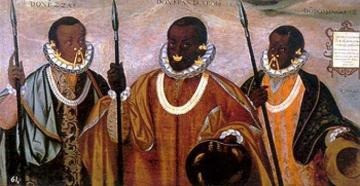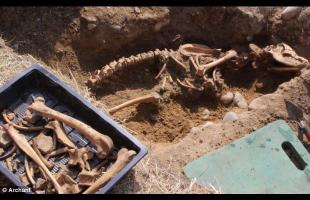The black chiefs of Esmeraldas


In 1533 something very particular happened in the New World, on the current Ecuadorian coast of Esmeraldas, so called because it is very rich in these precious stones.
At that time, the petty trade in African slaves had already been taking place for several decades, but precisely around the second half of the 16th century it was increasing and assuming enormous importance. In general, the slave trade, whose monopoly was in principle held by the Spanish and Portuguese, developed around a lucrative trilateral trade.
Traders of human merchandise arrived in Africa with alcohol, weapons and junk that they exchanged for slaves with local rulers. Later, they resold the slaves in Coro or Cartagena de Indias, obtaining gold, tobacco, cocoa, sugar cane, cotton and coffee in exchange. With these goods they returned to Europe and prepared to embark on another journey.
Starting in 1540, also in the newly founded viceroyalty of Peru, slaves were needed for the arduous work in the fields.
The Spanish galleons that left the port of Panama headed south towards the City of the Kings, later called Lima, a name that evokes the indigenous people who lived in the area where Francisco Pizarro founded his capital.
One of those galleons, whose owner was Alonso Illescas, headed to Peru in October 1553. On board, in addition to various merchandise to be delivered there, there were twenty-three African slaves (17 men and 6 women). The sailboat stopped on the current coast of Esmeraldas for approximately 30 days, due to a total lack of wind.
When, finally, there was a light breeze, the Spanish galleon resumed its march towards the south, but the commander decided to stop after passing Cape San Francisco, and dropped anchor in a bay called Portete. The objective of the stop was to look for fresh water, fruit and, possibly, game meat, since during the long days of calm at sea all the supplies had run out.
The Spanish landed and took all the Africans with them, since they could help them in the search for food. During his absence, the wind began to blow with unusual force and there was a sudden storm. The galleon was dragged to the cliff and shipwrecked without those who had been left caring for it being able to do anything.
When the group that had headed inland in search of food returned to the bay, they realized that the irreparable had already happened: the galleon was destroyed and most of the merchandise had been lost. Taking advantage of the confusing situation, the twenty-three Africans escaped into the jungle.
The Spaniards did not react very astutely, since, instead of preparing to build a brig with which, by paying the cost, they could have saved themselves, they decided to undertake a difficult path along the coast, perhaps hoping to reach a town inhabited by other Europeans. Almost all of them died on the march: some from cerebral malaria, others from thirst and fatigue. Only a few survivors arrived, after months of adversity and indescribable hardship, to a remote village inhabited by settlers, but they perished just after recounting what had happened.
The Africans, on the other hand, managed to appropriate edged weapons and also some harquebuses that the Spanish had abandoned in the area of the shipwreck. They headed inland and entered a village of Pidi indigenous people, who were short and stocky, and who had somatic characteristics very similar to the current northern Siberians: almond-shaped eyes, very pronounced cheekbones and straight, black hair. They had been accustomed for centuries to living in a humid equatorial climate, where the jungle was very intricate and insidious. Also the Africans, originally from the Gulf of Guinea, found a natural environment very similar to that of their distant land, and they adapted quickly.
Upon the arrival of the foreigners to the town, the Pidi natives initially fled in terror. We can imagine the reaction, seeing 17 dark-skinned men and 6 women arrive, with somatic features different from his own: flattened nose, prominent lips, curly hair.
The Africans settled in the town and took all the food they could find.
When, a few hours later, the natives returned determined to expel the invaders from their territory, there was a violent battle from which the Africans emerged victorious, especially because they could count on the strength of iron weapons, such as axes and daggers; but also because his physique was superior.
The Pidi, suffering some losses, realized that the newcomers were tough guys and decided to enter into a pact, agreeing to submit to them.
It was then that a chief emerged, the African named Anton. A few days had already passed since the shipwreck, and in the Ecuadorian lands of Esmeraldas one of the most interesting cases of adaptation, symbiosis and syncretism between different cultures in the entire history of the human race was about to happen.
There were also other indigenous groups in the area: the peaceful Niguas and the warlike Campas, who soon realized the instability created since the arrival of the African intruders.
A few days later there was another bloody confrontation between the Africans led by Anton along with a group of Pidi, and the fearsome Campas.
The latter were victorious and six Africans lost their lives in the battle, in addition to several Pidi indigenous people.
The Africans had to retreat and, due to several successive skirmishes, only seven men and three women remained. After Anton's death, it was Alonso Illescas who assumed power, an African native of Cape Verde who had lived for many years in Seville as a slave to the shipowner of the shipwrecked galleon and who had been baptized with the same name as his previous boss.
It was then that the remaining Africans, realizing that they were surrounded by groups of hostile indigenous people who would sooner or later kill them, decided to carry out a diabolical plan: each potentially dangerous native would have to be killed; Only the docile, along with the elderly, women and children, would have their lives spared.
It was a true war for survival: the slaughter was cruel and most of the Campas were killed. Alonso Illescas was named chief of the Niguas and the few surviving Campas, and a beautiful young Nigua was offered as his wife.
After a few months of relative calm, Alonso Illescas was invited to a party of a powerful chief called Chilindauli, who was the king of a neighboring valley, near the current bay of San Mateo.
In the middle of the celebration, taking advantage of the drunken state of the chief Chilindauli and his most trusted men, Alonso Illescas and the other Africans attacked, killing the chief and most of the armed men. It was a vile and despicable act, but it is likely that Alonso Illescas premeditated it precisely to avoid falling victim to the natives.
After this ignoble victory, Alonso Illescas became the undisputed lord of the entire area and even carried out looting in the vicinity of the city of Puerto Viejo, inhabited by Spaniards and indigenous people.
Meanwhile, the seven remaining Africans had mixed with several native women, and already in 1600, forty-seven years after the shipwreck, there were about fifty zambos, or children of the union between Africans and Amerindians.
In 1565, Illescas dominated an immense area and his growing power was beginning to worry the Spanish in Puerto Viejo.
In all these years of staying in the ancestral lands of the Pidi, Campas and Niguas indigenous people, the Africans adopted some uses, customs and traditions of the natives they had conquered. There was a syncretism between the African tribal religion and the local beliefs of the natives, based on the cult of the Sun and the Moon.
Anton Illescas and his lieutenants adorned themselves with gold earrings and rings that they put on their noses, and with dazzling emeralds.
They dressed in cotton clothing woven by the indigenous people, but they also used some accessories typical of the Spanish conquistadors, such as the white cotton necklaces seen in the main portrait.
Since it was not advisable for the Spaniards of Puerto Viejo to organize a military expedition against the army of Illescas, they thought of granting some privilege, such as a title of governor, in exchange for obtaining a conversion of the rebels to the Christian religion.
Miguel Cabello Balboa, author of the work True Description and Long Relation of the Province and Lands of the Esmeraldas, was sent to negotiate with Illescas to obtain the conversion and submission of his kingdom to the Spanish Crown, but he returned to Puerto Viejo without having achieved nothing.
In 1598, the black chiefs of Esmeraldas had further consolidated their rule and were the main interlocutors of the Spanish government in Quito, which was increasingly concerned about how to conquer those rebellious regions for the Crown.
During the following century, the population of the Zambos grew greatly, and the majority settled in the towns of Esmeraldas Vieja and Atacames. It is estimated that, in 1670, there were hundreds of descendants of Africans who survived the shipwreck.
From official documents it is deduced that, in 1607, the black chief Sebastián Illescas (a successor of Alonso), was still the undisputed dominator of Esmeraldas.
In subsequent centuries there were other waves of “forced” migrants in Ecuador, a country in which, currently, 75% of the population is mestizo, while Afro-descendants are 5% of the total, or just under 700,000 people.
YURI LEVERATTO


















